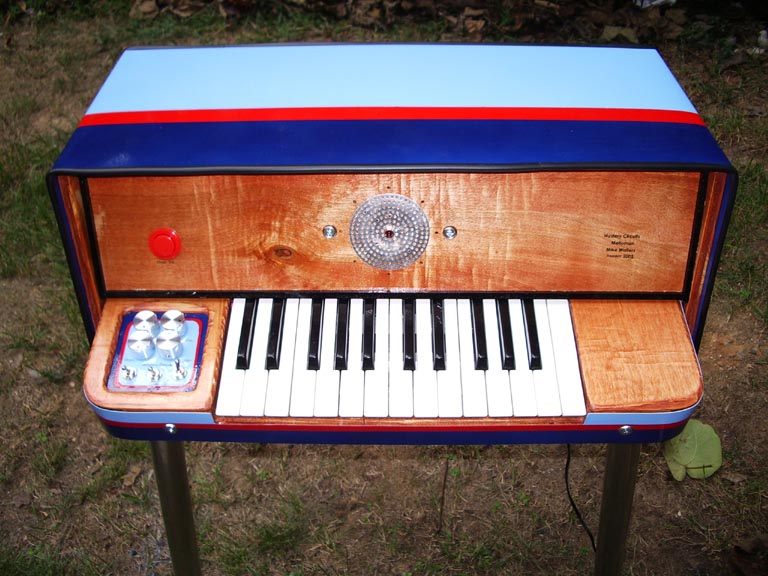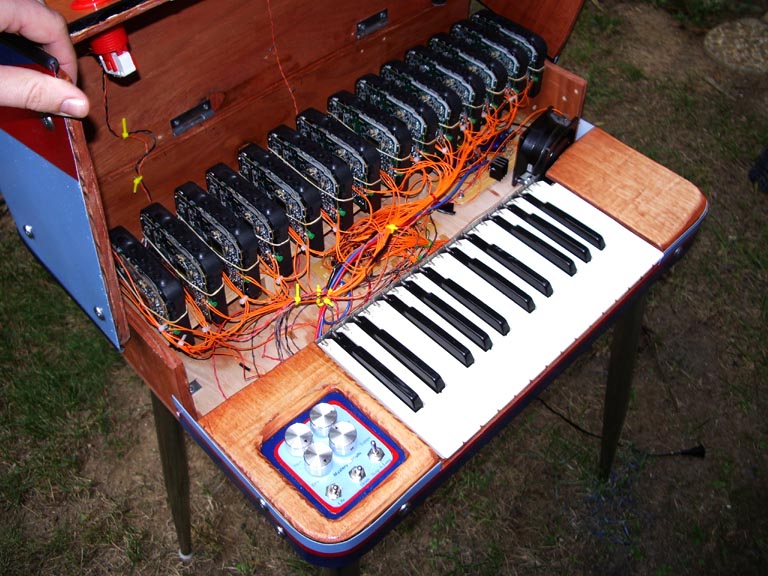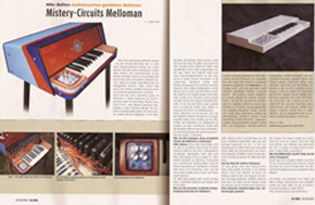












Mystery Circuits, LLC

By Mike Walters - Chapel Hill, North Carolina


The Melloman
First version, built 2005 in Carrboro, NC
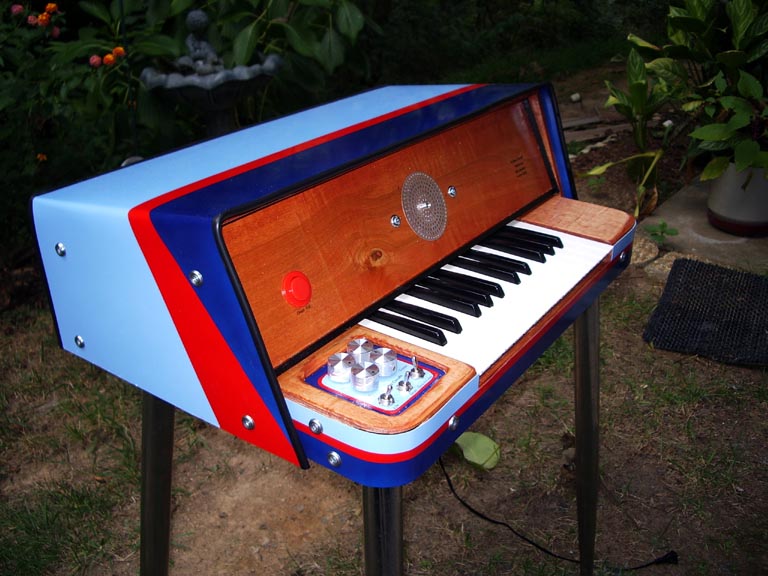
I built the Melloman back in 2005, and it was the first (and only) thing I built to almost go viral. Maybe more like a mild cold. This page was picked up by Gizmodo and Engadget, then other blogs, and suddenly this site went from a few hits a day to thousands. For a few days, I remember refreshing my email every few minutes, and there would be a few new messages about The Melloman.
That attention quickly waned, but I still get emails about the Melloman every few months. A few people have built thier own versions, and I'm always glad to answer any questions.
Here's an email I got from Genesis P-Orridge (RIP) not long after I published the page in 2005. Not happy.
I built a programmable drum machine version, called The Drumssette, five years later, and was commissioned to build an updated Melloman in 2013 for Justin Vernon of Bon Iver. Anyway, here's the page with all the same text written back then.....
2005:
This is my interpretation of the Mellotron, a classic instrument invented in the 1960s. It was one of the first sample players, and was used by The Beatles, and countless psychedelic and prog bands. The Mellotron played strips of tape to emulate flutes, strings, choirs, orchestras, etc. The flutes at the beginning of Strawberry Fields are a good example of the Mellotron.
My version, The Melloman, uses Walkmans and cassette tapes to play original Mellotron samples, or whatever cassette tapes you want to put in. Inside the box, there are 14 continuously running Walkmans mounted side by side. The first Walkman is designated for drums, and the next 13 provide sampled loops for 25 notes.
The operation is pretty simple. Each cassette tape contains 2 octaves of each note hard-panned left and right, on a continuous loop. There is one Walkman for each note, supplying two octaves. For example, Walkman #4 plays a cassette designated for D. The left channel track has the lower octave D constantly playing, and the right channel has the higher octave D. This allows 13 Walkmans to produce 25 notes (the last Walkman for C4 uses only one track). Walkman #1, the drum player, plays a constant loop of Jett Rink’s drummer Tony Stiglitz on the left track, and doing fills synched and looped on the right track. A momentary switch (the big red arcade button on the front) causes the drum fill in perfect time with the main rhythm. There is also a potentiometer wired parallel to that Walkman’s motor speed trim pot. This allows for tempo control, albeit crude (but that makes it cooler).
Each note (cassette) is constantly running. The keyboard basically allows the notes to pass to the output. I got the keyboard from a junked Casio CT-310 (see my Wilgamat mod for the same idea) and rewired the switch matrix to bridge each contact to a common bus, which is +1.5v DC. When a note is pressed, the voltage is sent to a corresponding NPN transistor. Originally, I was going to use opto-couplers (a component combining an LED with a photo resistor) to key each note. The signal would pass through the photo resistor, and pressing a key would send voltage to the LED causing the volume to rise.
When experimenting, I found they provided really nice, natural attacks, but the notes wouldn’t decay back to silence for almost one minute. Transistors are a lot more harsh, but a lot more accurate.
The switch circuit contains 28 NPN transistors (2N4401). The audio tracks from each Walkman (left and right channels hardwired from circuit board, 28 tracks total) are sent to the emitter pins of all the transistors. When a key is pressed, the voltage from the bus is sent to the base of pin of the corresponding transistor, thus allowing the audio signal to pass to the collector pin. From each collector pin, there is a 10k fixed resistor which bridges to another bus. This is basically a simple, passive mixer, and that bus becomes the master audio signal. Since the mixing is passive, there is some slight volume loss the more notes are played.
On the control panel, there are 4 knobs and 3 switches. The knobs control Master Volume, Tone, Drum Volume, and Tempo. The Master Volume simply grounds the main audio signal when turned down. The Tone is a simple single-capacitor low pass filter, the Drum Volume works by limiting voltage to the base pin of the drum transistor, and the Tempo is a 50K potentiometer wired parallel to the motor trim pot of the drum Walkman. Switch 1 is DC power (1.5V), Drum on/off, and Sing-A-Long. The Sing-A-Long function allows the drum Walkman to play both left and right channels at the same time. This allows you to play along to a regular music cassette. I thought Sing-A-Long sounded better than Play-A-Long. This idea came along when I was doing some testing. I accidentally placed an ELO tape into the highest C Walkman. So it went G..... G#..... A…. A#….. B…….. “Eeeevil Woman”. So I started playing along with the tape, and said hey this is a fun activity I’m doing. Anyway, that’s how that feature was born.
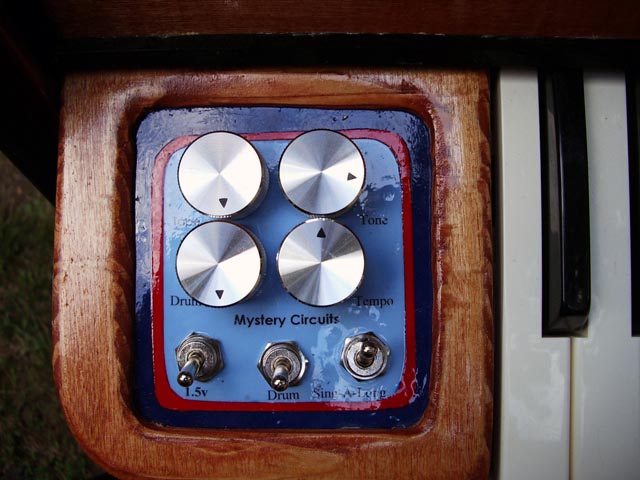
The biggest hurdle of this project was the power supply. These Walkmans weren’t designed to be part of a keyboard instrument, therefore the convenience demographic centers more on runners, walkers, teens, and general cassette enthusiasts. They just want to pop in a AA battery and go. Life doesn’t stop for 3v, or 4.5v, or 6v, or even 7.5v. These Walkmans are designed for 1.5v (aka a AA alkaline), and I have them wired to each other parallel. During first tests, I used a D cell battery. That would power all these Walkmans for about… oh 20 seconds. I ultimately wanted to use AC to power these, and that would have been much easier if I could have used 3v, or 4.5v, or 6v, or even 7.5v. Low voltage for these means high current consumed, thanks to Ohm’s Law.
Many thanks to Sailormouth who helped me with the power supply design, and my current situation. I built a 1.5v DC power supply to work off of 120V AC (Mains), but unfortunately all those Walkmans consumed more than 1.2A the transformer allowed. I used a Forest Mimms schematic using a LM317 adjustable voltage regulator and a 12.6V transformer. For one, this set up didn’t allow enough current, and it would overheat rather quickly. So I thought… hmmm. Why don’t I just divide the Walkmans in half and build 2 power supplies? Bingo, that was the solution. I built two identical power supplies on one circuit board using two 12.6V transformers. The regulators still ran a bit hot, so I used heatsink and a 120V AC fan pointed right at them. Heat is no longer an issue, and I have low voltage with plenty of power.
The case for the Melloman was built from scratch out of oak and steel. I wanted a hood that opened easily to access the electronics, and I had kind of a combo-organ look in mind. I did some sketches early on, and it ended up looking pretty much just like what I drew. The only tools I used were a jigsaw, drill, Dremel, and a sander. The legs I borrowed from my Melosonic combo-organ. The color scheme was inspired by a Global Van Lines truck that my wife and I saw on a road trip. She suggested it. I was pretty indecisive between red, orange, or maybe yellow. I liked the dark blue, baby blue with a stripe of red. As a general rule, I really like blue and red together.
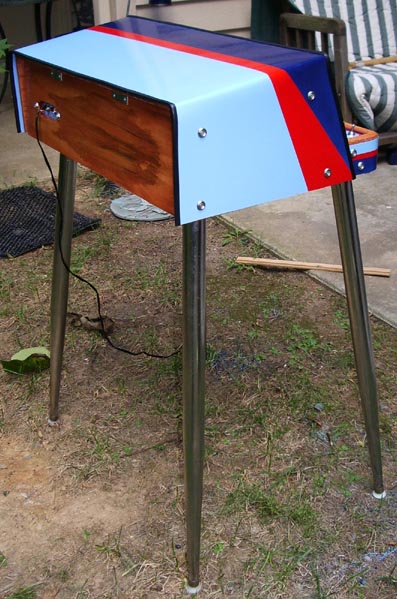
There’s a built in speaker on the front of The Melloman. It deactivates if a ¼” cable is plugged into the output. The speaker grill on the front is actually a shower drain cover I bought new for $1.50. The back of the Melloman has a master mains power switch, a ¼” audio output, AC cord, and a neon power indicator. Turning the master power switch will turn on the fan, but the rest of the instrument is off until the 1.5v switch on the front is turned on.
My good friend Alex Maiolo helped me with the actual Mellotron samples. He has a rather extensive library of original Mellotron sounds on his computer, and let me use whichever ones I wanted for this project. I went to his house and recorded each note of two octaves for six seconds, and he burned everything on CD. The sounds I recorded were flute, choir, strings, brass, and orchestra. Once I had all the notes on disc, I took it home and put them on my computer. Using Acid and SoundForge, I took a section of each note, and looped it so it would play constantly. On the original Mellotron, there was an 8 second limit for all the sounds. Since they were on strips of tape and not looped, the note would run out, and have to be brought back in via a spring. Using the program Acid, I mixed the two constant loops of consecutive octaves, and hard panned each to the left and right channels. If you took one of these tapes and put it into a regular stereo cassette player, you would hear both octaves at the same time separated to each speaker.
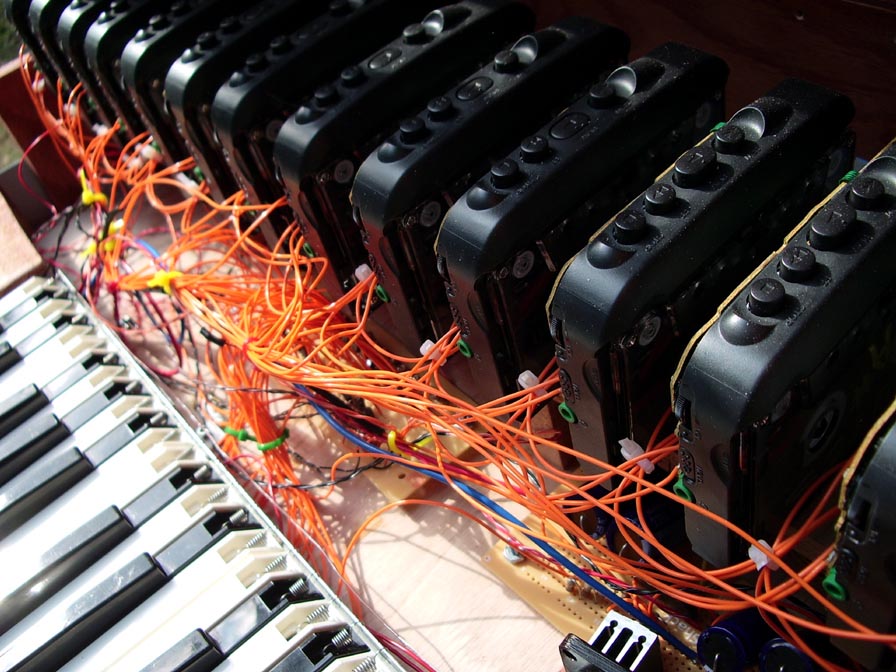
The drum tracks were recorded live at band practice by Nick Petersen. I had our drummer, Tony Stiglitz, play a measure of a rhythm and do a fill, and repeat twice. He did a Motown beat, a rock beat, disco beat, samba, and ska beat all with a couple of fills. I used the same method as the notes for the drums, but they are keyed differently. The momentary switch I used is the type that can be wired normally open or normally closed. The main drum track (left channel) is wired to a transistor using the normally closed lug of the switch, and the fill (right channel) is wired to a transistor using the normally open. When the switch is not being pressed, 1.5v is sent to the left channel’s transistor base pin causing the main rhythm audio to pass to the mix. When the switch is pressed, the voltage is rerouted to the drum fill’s transistor base, allowing that audio to pass. The Drum Volume knob regulates that voltage before it goes to the switch, and produces 1.5v when turned all the way up, and 0v when all the way down. The Drum Pitch is lots of fun too because the results become extremely low or extremely high.
Certainly, The Melloman isn’t confined to its intended use. Really cool sounds can happen when putting a tone of some sort into the drum Walkman and messing with the Pitch knob. Books-on-Tape would be really fun to play with the keyboard. Just imagine how the plot of the story would be affected by real time Choose Your Own Adventure. It wouldn’t make any sense in the end. Another cool thing about the original Walkmans I used is the radio and TV audio receivers on each one. Having each Walkman set to a slightly different AM frequency will produce fun heterodyne tones and pick up fantastic radio interference from each tape motor.
Here are some .mp3 sound samples of the Melloman....
The following samples of the Melloman were performed by my friend Mark Lewis. Mark resides in Carrboro NC, and is a professional piano/organ player as well as a multi-instumentalist.
Sound Sample Mark Lewis performing Strawberry Fields on the Melloman
Sound Sample Mark Lewis performing Lucy in the Sky with Diamonds on the Melloman
Sound Sample Mark Lewis performing Penny Lane on the Melloman
Sound Sample Strings and Drums through mutron phaser spacey fun

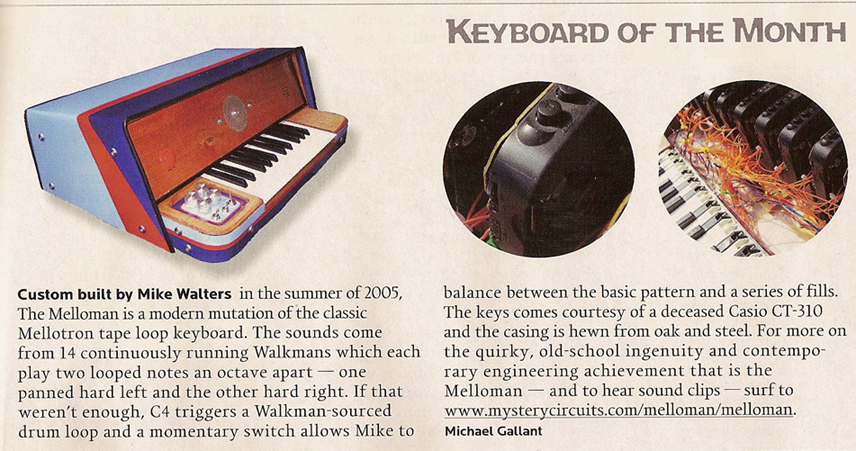
The Melloman was Keyboard Magazine's Keyboard of the Month back in April 2006

Featured in German magazine Keyboards March 2006, article by Joker Nies
